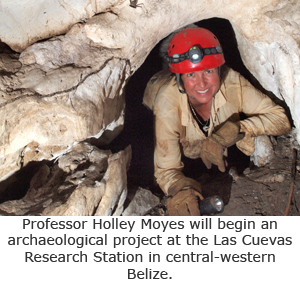

Studying ancient remains, exploring caves, publishing books, leading workshops and presenting papers are just a handful of the things that will keep faculty busy this summer in the School of Social Sciences, Humanities and Arts.
Though the semester ended in mid-May, the campus’ focus on creating and sharing new knowledge continues year-round. Summer offers faculty members a chance to focus their energy on their research.
The following is just a sampling of how the 48 ladder-rank faculty members in SSHA will spend the next couple months.
World cultures Professor Maurizio Forte will go to China to continue his digital archaeology in the Xi’an province. He’s beginning a new phase of the project with the Jiaotong University to create a virtual museum of the West Han Dynasty.
Forte’s research involves using laser scanners and other cutting-edge technology to recreate ancient worlds in the 3D that can be explored by fellow researchers.
Along with graduate and undergraduate students, Forte will also travel to Turkey to continue his work at Çatalhöyük. He will also begin a project with California State Park at Fort Ross.
Dean Mark Aldenderfer will continue his work in Upper Mustang, Nepal on ancient Transhimalayan migrations. National Geographic TV is filming the project for a documentary. National Geographic magazine is also planning to write an in-depth article on the work. Aldenderfer will also go to west Tibet finish a project on climate change in 1300 AD, a project that’s sponsored by the National Science Foundation.
Historian Ruth Mostern is going to China where she will deliver a paper at the World History Association conference in Beijing. She will then travel to Zhengzhou to visit the Yellow River Water Conservancy Commission to look at their historical archives and museum and to tour the river in that region in support of a project she’s beginning about the river.
Literature Professor Ignacio López-Calvo will be reading his paper “Lima + Sevilla = Okinawa: The Japanese as Caricature in Fernando Iwasaki’s ‘España, aparta de mí estos premios’ ” in Valencia, Spain, at a July conference organized by the International Federation of Studies about Latin America and the Caribbean.
Professor Holley Moyes will begin an archaeological project at the Las Cuevas Research Station in central-western Belize. Along with graduate student Justine Issavi and undergraduate students Erin Ray, Makenna Chambers and Reem Yassine. They will be exploring a large site with temples, a ball court and a cave. There are also a number of unusual mystery structures that that the team will investigate as well.
ShiPu Wang, an art historian at UC Merced, is having his book, “Becoming American? The Art and Identity Crisis of Yasuo Kuniyoshi,” published by the University of Hawaii Press.
Drawing on previously unexamined primary sources, the publisher notes, this is the first scholarly book in more than two decades to offer an in-depth and critical analysis of Kuniyoshi’s pivotal works, including his “anti-Japan” posters and radio broadcasts for U.S. propaganda and his coded and increasingly enigmatic paintings, within their historical contexts.
The lab of cognitive science Professor Chris Kello is working on a computational model of a neural network to investigate information processing in the brain. Specifically, the researchers are using computational modeling techniques to investigate how a process called “critical branching” might help regulate and organize activity in the brain and how it might help it produce interesting and useful computations. Graduate student Janelle Szary’s work focuses on applying this model to tasks in visual perception, such as motion processing and object recognition.
Kello and Szary individually will present their work this summer at the 33rd annual Cognitive Science Conference in Boston.






